We take a look at the evolving styles of writing between G. Willow Wilson, Saladin Ahmed’s, and Samira Ahmed’s run of the character
Enough can’t be said about Kamala Khan. She’s one of Marvel’s biggest heroes to debut this past decade. She’s also, the first Pakistani Muslim female superhero ever created, not just for the Marvel intellectual property catalog, but also, ever in existence. For someone who’s going to be a major part of Marvel Phase 4, there really isn’t as much coverage on Kamala, nor is there as much buzz circulating around the cultural zeitgeist as your average MCU superhero.
To be fair, Kate Bishop had begun similarly up until her December debut (though was gifted with Hailee Steinfeld who’d really hyped the character). Though much like your average MCU and games fan, admittedly, besides the Square Enix video game for Marvel’s Avengers, I really didn’t know anything about the character.
But with a Disney+ series coming out later this year, and plans to be featured in The Marvels’ movie, there’s a lot to love about Kamala Khan’s origins, her personality, and really, just her comic book history. She’s got a lot of meta-multiverse potential given her love of all the Marvel franchises (a fangirl within Marvel itself, a great setup for a lot of meta-references and team-ups), and in many ways, is being prepped to one day be a face of the MCU’s young new generation of superheroes very soon.
Created by Sana Amanat, Stephen Wacker, Adrian Alphona, and G. Willow Wilson, what the new Ms. Marvel did for comics recontextualized and paid homage to the original role left behind by Carol Danvers. All by putting a modern and more culturally relevant spin on the hero. To serve as a young adult hero, fangirl, and role model for youths everywhere, sort of like Spider-Man did for generations before her.
Having just read the run of the comics for my interview with Samira Ahmed, I thought it would be best to break down a bit about the history of the character. Comparing the first three series runs and how the stories evolved over time.
G. Willow Wilson’s Run – The Ms. Marvel Relaunch
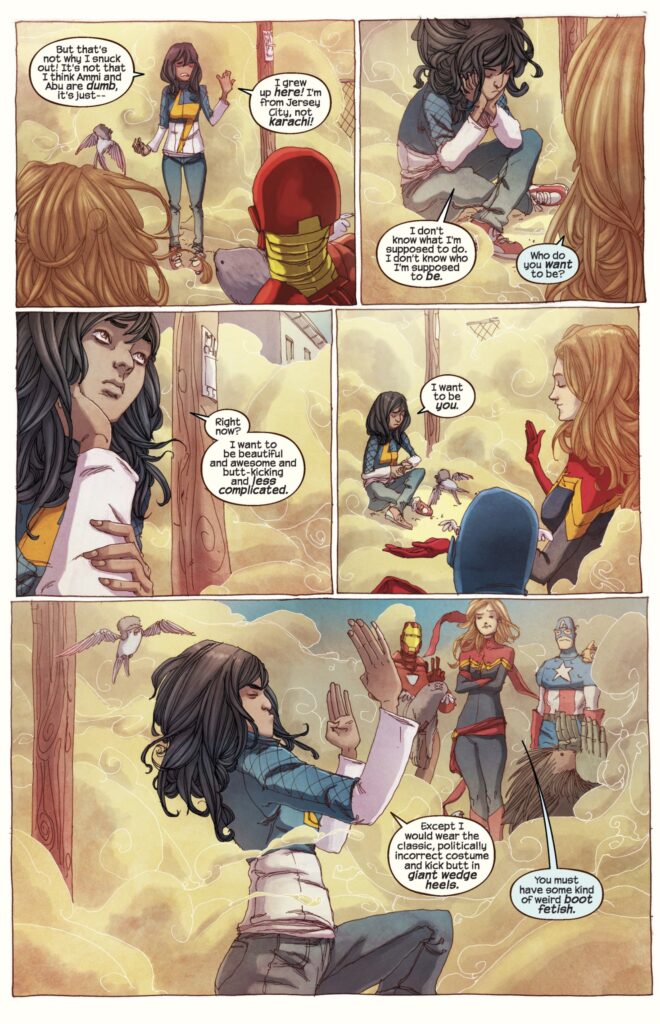
The original issues of where Kamala got started. What I loved most about G. Willow Wilson’s run was just how genuine she felt as a character. A girl whose authenticity and relatability was marred at the time of release by narratives criticizing declining comic book sales, yet also, ironically, in the cultural hindsight of the grand Marvel-branding plan, heavily praised in the present day for its representation in attracting a new and youthful audience.
What stood out was Willow’s portrayal of Kamala’s Islamic and Pakistani experience. A cultural background that often conflicted with teenage issues that felt oddly genuine yet also incredibly foreign. The comic, quite literally begins, over Kamala’s hunger-filled longings and inability to eat infidel meat. Bringing pakoras to school for lunch. Feelings of isolation over her faith. There’s a genuine outcast type of emotion here for youths of that cultural backdrop, and the kinds of isolated feelings of ‘uncool’ that I think Marvel has spent decades of representing.
Then of course there’s the usage of Urdu and the realized rituals of the Muslim faith. Kamala’s close knit ties to her family; with her brother Aamir feeling like an authentic lost yet meant to be the responsible, older sibling, and Asian parents with high expectations. It was how Willow’s run never pivoted away from Pakistani-American Muslim culture, therefore truly stand out.
In Willow’s words herself, it was the realism in diversity, that really made those early issues. Not in some checkbox photo opportunity sense that we often see portrayed in the media (looking at you final battle girls of Avengers: Endgame featured below), but in genuinely portraying what it is like as a brown Islamic girl of color, growing up in the densely populated and racially diverse state of New Jersey.
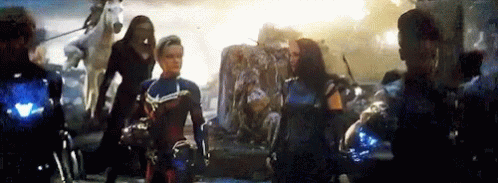
I say this… because I’m a Filipino American person of color who has spent the better part of my life living right by Edison, NJ. One of the most heavily populated and racially diversified towns in the US with an over 40% Asian population, many of whom, are of Indian and Pakistani descent. It is the same town that actor Kal Penn once criticized journalist Joel Stein about, regarding the journalist’s criticisms of how Indian-influenced the predominantly white town – named after the now more controversial Thomas Edison nonetheless – had become.
It is, as was strangely put by my peers in college, a very Asian haven of sorts – where fitting in didn’t feel all that strange, compared to other states across the US. Kamala in every way hits those beats. Her voice sounds like all those kids I grew up with in NJ.
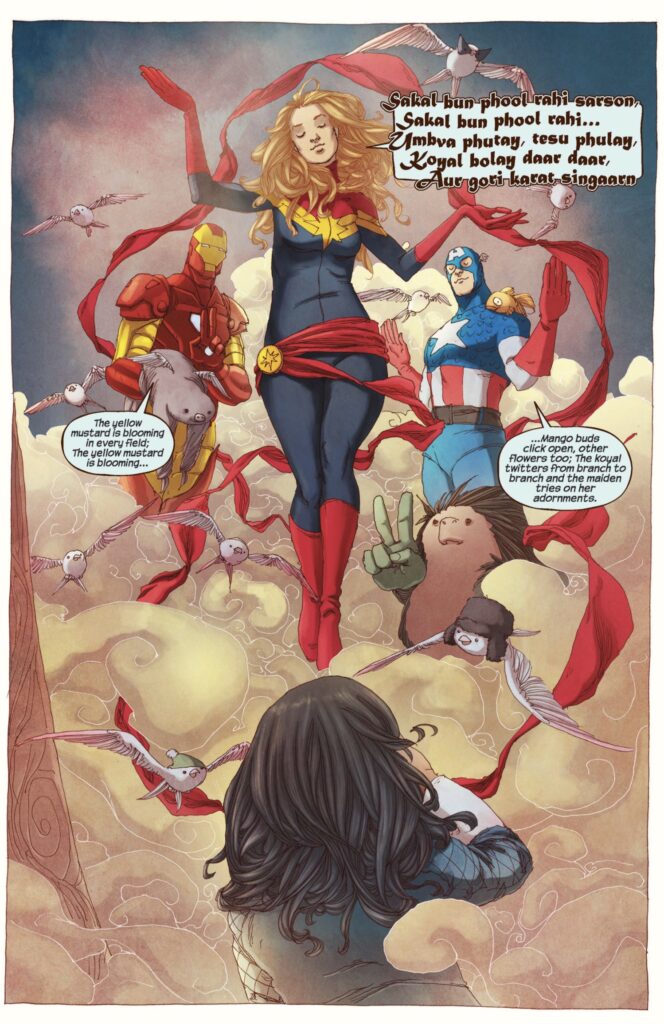
Though if that feels slightly isolating for kids of non-minority descent, I think Willow’s balance in finding its audience was also in establishing Kamala as this gigantic fan of the overall Marvel community. As the fan fiction and Kamala’s genuine love of the heroes we adore was hard to ignore. It was a love that felt strangely sincere, and not in a gratuitous breaking all the laws of censorship sort of way, but rather in a celebration of Marvel as a whole.
Kalama is a fangirl. A tried and true geek like Peter Parker before her. She’s brilliant at school, loves comic book heroes, and even plays World of Battlecraft. Which was an excellent reference to the popular MMORPG World of Warcraft at the time (of which I am also a fan). Willow’s run gave us a unique voice for a person whose marginalized representation, finally got to truly shine. All in a relatable love letter that spoke to Marvel fans.
Saladin Ahmed’s Run – The Magnificent Ms. Marvel
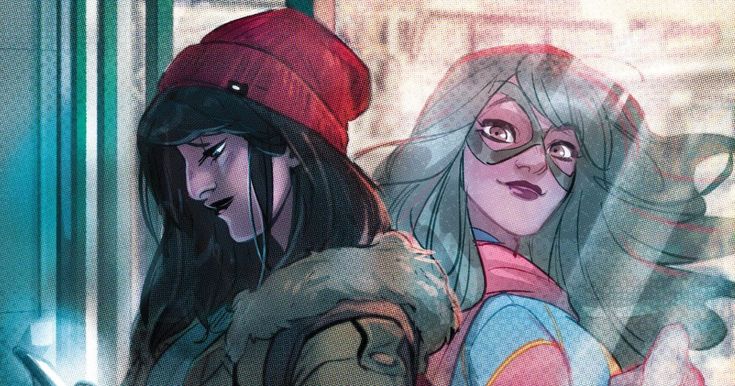
It wasn’t easy following in Willow’s footsteps, but Saladin Ahmed made a pretty great transition for a hero loved by so many people. The second Islamic author to take the helm of the character, like Willow’s run, most of Saladin’s was pretty respectful of their religion. And in 18 issues, I learned a lot about the Muslim American experience, Kamala’s love of Habibi’s, and more than ever: really gathered a sense of the NJ Pakistani experience. We even get some callbacks to central Jersey in this one (which is where I’m from).
Culturally, there are tidbits here such as the no-touching before marriage rule. And even, an awkward kiss that had been hinted at since the beginning of the series. Where Willow sets up the universe, Saladin’s run sort of ran with what was there and gave it the YA tropes expected out of teen comics in its three-volume run. Issues about teen romances, finding one’s identity, and really, balancing one’s circle of friends—during an awkward period of growth and self-discovery.
Kamala at this point really comes into her own. This is why Saladin made the courageous move in focusing in on the world outside of her head. Whereas Willow’s run kept the parents mostly to the sidelines, Saladin’s starts with mom and dad in danger front and center. Facing not just some regular foe, but her father’s own mortality—causing Kamala to grow up more than ever before.
In Saladin’s volume 1 of Kamala asserting to her parents that she is Ms. Marvel—and with that acceptance of her superheroism and ability, comes great responsibility—we see a lot about how the world around Kamala perceives her. It’s a story about facing destiny and how even in the wake of the tragedy, we find strength.
It’s a brilliant way to start the comic as fans become more comfortable being out of Kamala’s headspace. Hero, daughter, and even Chosen One, Kamala’s roles seen from outside of her point of view create the foundation of her exterior world-building. Especially, regarding Kamala’s rogues’ gallery, which was greatly developed during this run. The invention of the Rubicon, run by the Amazon-like CEO Brett—who looks like Steve Jobs in a turtleneck—I think villain fans will love to revisit in Kamala’s universe.
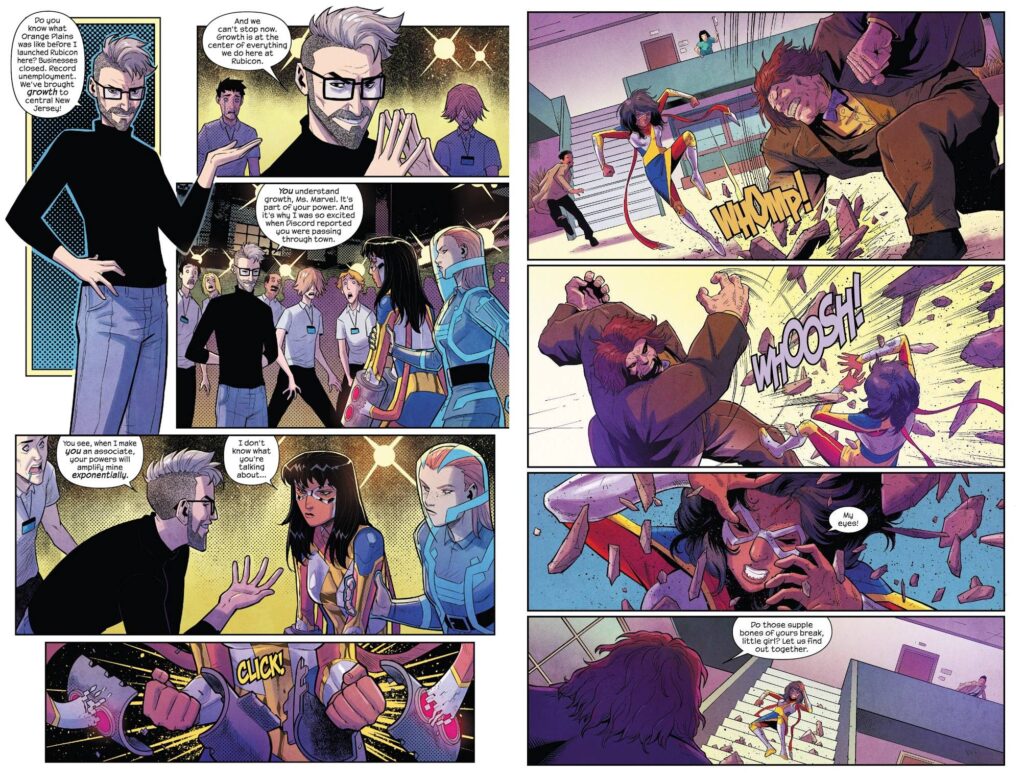
I also think more than anything else, these issues really expand upon the art styles. Minkyu Jung and Eduard Petrovich really emphasize the stretchy and engrossing nature of her abilities. It’s awkward, yet fun, with depictions of muscular Hulk-Kamala and even parachute Kamala. All for a fun and unwieldy exploration of her powers.
Whereas Mr. Fantastic focused on elongation and his wrap-around torso, I always find Kamala slightly more weighted on the fists and giant hands. Her awkwardness fits versus Fantastic’s seriousness, when to be honest, stretchy powers are rather silly. Atop of this, making her appendages large/big play with a lot of foreshortening techniques, which makes her visuals a bit fun, not unlike how Spider-Man plays with his dynamic movement while traversing.
Saladin Ahmed’s run definitely tailored Kamala as more of the superhero archetype. It was a great expansion into her universe that left audiences with a threading narrative that could further explore her abilities and rogues. To a large extent, his spin of her story mimics the original takes on Spider-Man. If that wasn’t enough, the introduction of the Kree alien suit, the Stormranger suit, is in many ways reminiscent of the spider symbiote. An entity of the self turned archnemesis. Though I think it fits Kamala’s universe.
Samira Ahmed’s Run – Ms. Marvel Beyond The Limit
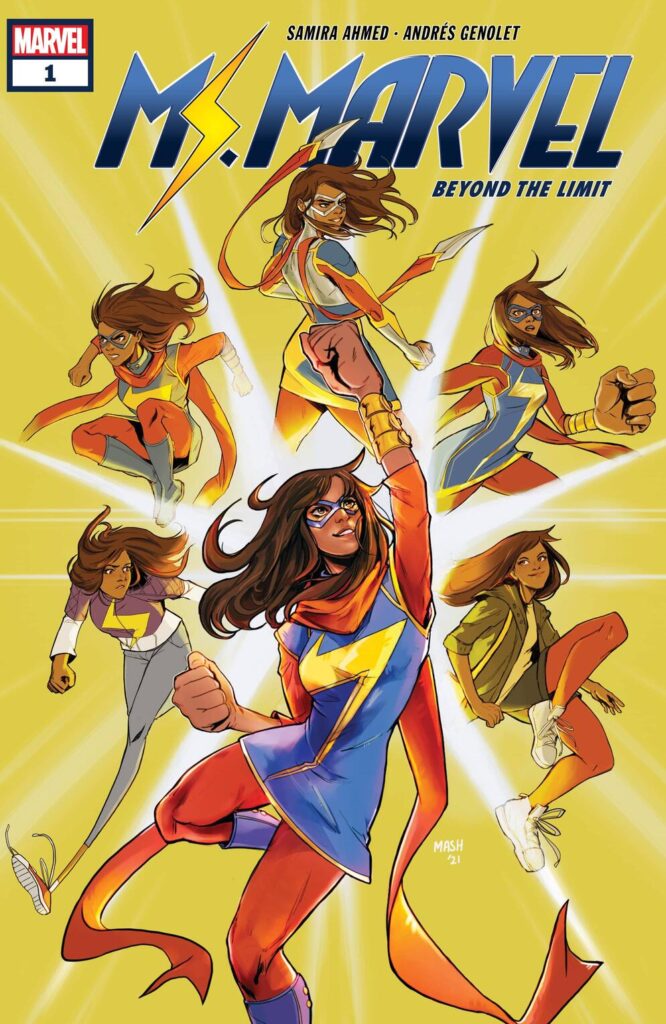
To be fair, we’re only two issues into Samira’s run of Kamala. But I do think Samira’s done a good job so far, tapping into Willow’s original voice. Kamala’s most definitely the teen girl in a YA novel, but to be honest, it’s a very Gen-Z feeling. And it fits Samira’s career almost perfectly.
In her run so far, there’s this funny obsession with food early on like Keema Parthas and hot dogs, and as the series kicks off in Chicago instead of Kamala’s usual Jersey City. Which I will say, as someone who’s explored both cities relentlessly while traveling (at least, I know of their food scenes well), everything about that food culture wise: was rather spot-on.
I also enjoyed the introduction of cousin Razia who cofounded L.A.M.P., League of American Muslim Professionals and really, just the focus from the get-go on women in S.T.E.M. which goes well with the current iterations of Janet van Dyne. As we need more women in the sciences and not much is being spoken about that. Samira brings these issues to light brilliantly: showcasing the next generation of women. What they can do. And what they’ve been vying for the chance to prove.
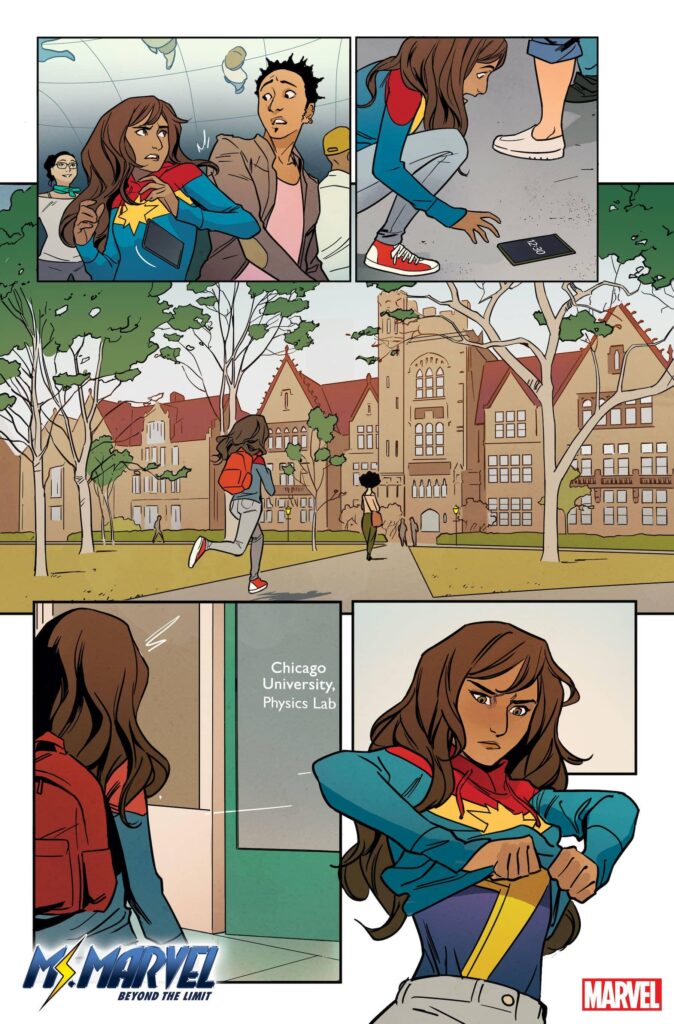
More than anything, though, I think we’re setting ourselves up for a Kamala Multiverse. And given all Kamala’s parallelisms to Spider-Man, multiverse heroes, just like Into the Spider-Verse are all the rage.
The Abu and Ammi dance. The Bollywood Jersey City swooning over acid raid in the state. It’s silly. But it works for Kamala-verse. Where the potential to see the character’s growth, measured and compared, over the past eight years really comes to light.
Given our talk, I will say that Samira seems like the kind of person who knows how to represent character narratives well for Islamic young women. More importantly, she knows that Kamala is fun! The kind of hero you’d want on your team in an awkward embiggening, foodie adventure kind of way.
I think she’ll do great with this run.
